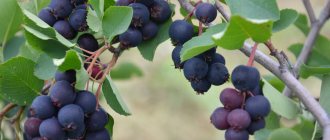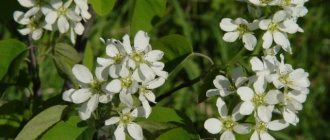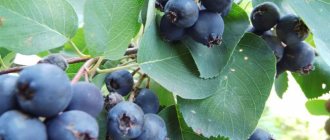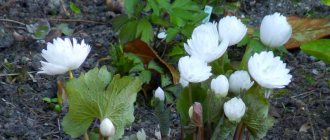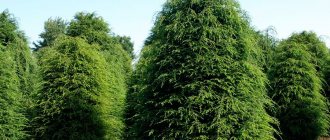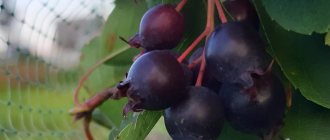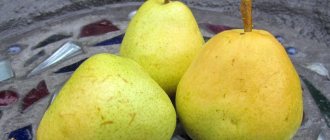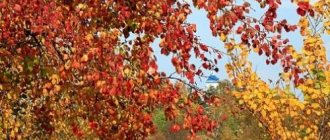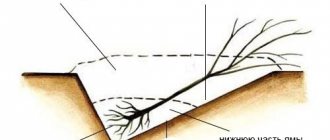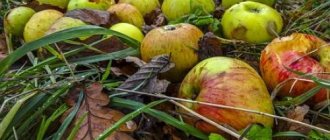The genus serviceberry belongs to the rose family, apple subfamily and includes 25 species. Wild thickets of serviceberry can be found in North America, Europe and Asia, China and Japan, the Caucasus and Crimea. Heat-loving species grow in the south. For the Russian climate, winter-hardy forms, whose homeland is North America, are more suitable.
This is interesting! All species are similar to each other and interbreed easily. In this regard, difficulties arise in determining the species of serviceberry. These are mainly shrubs with an elongated crown up to 5 m in height, less often - trees up to 12 m.
The leaves of representatives of the genus are simple, long-petiolate, alternate, up to 7 cm long on average, oval or round. In autumn, depending on the species, they turn yellow, orange, red, crimson or purple. The flowers are star-shaped, five-petaled, white, 1.5–3 cm in diameter, collected in 5–15 racemose inflorescences. The fruits are round, dark blue or dark purple, covered with a bluish waxy coating, up to 1 cm in diameter (up to 2 cm in fruit varieties), edible.
General description of culture
Irga Lamarca is a compact tall bush or small tree. It belongs to the Rosaceae family, the apple subfamily, so its fruits are sometimes called apples rather than berries. Unites under a common name several varieties that are planted both for landscape decoration and for harvesting. The homeland of Lamarck's serviceberry is Canada. In addition, it is found wild in the Crimea, the Caucasus, Europe and even Japan.
Irga Lamarca is often considered an ornamental subspecies of the Canadian serviceberry and this shrub is called the Canadian serviceberry Lamarca, although this is not so. Difficulties and confusion in classification are due to the fact that different wild varieties often grow nearby and are cross-pollinated.
Beneficial features
The fruits of this plant contain many substances beneficial to the human body that help it resist:
- Stress.
- Infections.
- Oncological disease.
- Alzheimer's diseases.
- Cataracts.
- Night blindness.
Saskatoon also has anti-inflammatory, astringent, wound-healing and detoxifying effects.
Plant a shadberry in your garden and in one plant you will get a beautiful honey plant, a decoration for your garden, a tasty juicy berry, and, finally, a whole complex of substances that are beneficial to the body. Well, the agricultural technology of its cultivation is within the capabilities of even a novice gardener.
Description of the species
A mature tree is usually formed from one or more trunks. It is quite easy to recognize this shrub by its characteristic cap-shaped crown. The height of the Lamarck serviceberry in comfortable conditions can reach 8 m; in our latitudes the shrub rarely grows above 5 m. Its main characteristics are given in the table below.
| Parameter | Meaning |
| Type culture | Deciduous shrub or tree |
| Root system | Powerful, well developed |
| Escapes | Smooth, grayish-green, rough |
| Crown | Umbrella or cap-shaped |
| Leaves | Green, oval-shaped, with long petioles. The leaf blade is matte, the edge is serrated. Leaf length is up to 7 cm. Color in autumn varies depending on the species to yellow, orange or purple-red |
| Flowers | White, small (3.5–5 mm), have five petals. Collected in large inflorescences of 5–15 pieces. |
| Fruit | Purple to black, 1 cm to 2 cm in size, with a characteristic bluish waxy coating |
Irga Lamarca perfectly combines the qualities of both an ornamental and a berry bush. Also its advantages are:
- low maintenance requirements;
- frost resistance and drought resistance;
- stable fruiting;
- ease of reproduction;
- good immunity to diseases and pests.
According to gardeners, it is these qualities that are decisive when deciding whether to plant Lamarck's serviceberry on a personal plot. Many also note the good taste of the fruit and its universal purpose. Despite this, the attitude towards this shrub is somewhat dismissive, since gardeners often prefer more “promoted” types of fruit trees and bushes. The usable area is occupied by apple or cherry trees, and the unpretentious serviceberry is planted somewhere in the backyard of the garden.
Which varieties belong to the type of serviceberry Lamarck
There are quite a few varieties of Lamarck's shadberry. Here are the main ones:
- Princess Diana;
- Robin Heal;
- Springtime;
- Ballerina;
- Traditional;
- Strata.
The last two varieties have a controversial classification, since some researchers classify them as Canadian serviceberry.
Princess Diana
Selected in the USA and patented in 1987. Author: Elm Grove. It is a tall branched bush or single-trunk tree with a wide (up to 6 m) crown. Height 5–7 m. Bark color is gray-brown.
Leaves are 6–7 cm long, lanceolate. In spring, the reverse side of the leaf blade is reddish in color and has characteristic pubescence. In summer, the leaves are olive-colored, the reverse side is slightly yellowish. By autumn the color changes to orange and red.
Yellow flower buds. Flowers up to 2 cm in size, white. The berries are small, 0.8–1 cm. Productivity is high. Winter hardiness up to -30 degrees.
Robin Hill
Bred in the USA, Pennsylvania. It has a tree-like shoot 6–9 m high, crown size 4–6 m. The leaf is oval-shaped, bright green, becoming yellow-orange closer to autumn. The flower bud is pink, the flowers are large, just bloomed pink, but quickly turn white in hot weather.
Young leaves are light-colored, with white edges; as they grow, they acquire a green color. In autumn the crown turns yellow-red-orange. The plant is great for decorating alleys, park areas, etc. The fruits are black-purple, with a bluish bloom, up to 1 cm in size.
Springtime
The plant is a compact large bush with straight shoots up to 3 m long. The leaves are oval, green, and by autumn the color changes to yellow and orange.
It is very rare in Russia; the irga of this variety is more common in Europe.
Ballerina
The variety was obtained in the Netherlands from seed material brought from Great Britain. Year of breeding: 1980. Author: Van de Laar. It is a massive tree or bush with a height of 4.5 to 6 meters. A photo of Lamarck's shadberry variety Ballerina is shown below.
The leaves are oval, pointed, up to 7.5 cm long. In spring they have a yellowish tint, in summer they are green. As autumn approaches, the leaves change color to red, orange and yellow. The flowers are white, large, up to 2.8 cm. The berries are purple-black, large, collected in clusters of 5–8 pieces. Reviews about the irgi variety Ballerina are usually enthusiastic; the plant is really very beautiful both during the flowering period and in autumn decoration.
Irga: description of the plant and common varieties with photos
It is very difficult to name even an approximate number of varieties. The discrepancy in data is due to the development of numerous hybrids. Some sources indicate that there are only 6 varieties of shrubs, others - 33.
Popular varieties are:
- Oval (the name round-leaved is very common) is the progenitor of many varieties. Its natural habitat is Central Europe, where the shrub grows well on dry slopes and embankments. A. Ovalis, under favorable conditions, can grow up to 2.5 meters. Characteristic features are the pubescence of young shoots, which turn red-brown when they reach maturity. The leaf blade is oval-elliptical, 4 cm long. During the growing season, the leaves change color several times from bluish-light green to bright red. Flowers are collected in lush inflorescences of 4-8 white buds. When fully ripe, the fruits become blue-black with light bluish pollination. Oval irga easily tolerates drought, but is sensitive to severe frosts.
Spica is a natural place of growth in Europe. Under natural conditions, it forms dense thickets 2.5-5.5 m high. This variety cannot be grown as an upright tree, since it does not have a central shoot. The branches of A. Spicata are flexible, but a large number of them form a very lush crown. The leaf plate is elongated, the shoots are red-brown, the buds are ivory-colored, the fruits are purple-red.
Alder grows naturally in North America. Cultivated on mountain slopes, hills, and near water bodies. Depending on the environment and neighboring plants, A. Alnifolia can be grown either as a bush or as a tree. When planted in groups, the shrub grows up to 2 meters. It enters the fruiting period at the age of five. The variety is highly resistant to frost and tolerates significant soil moisture.
Canadian serviceberry will decorate the garden with its shapes. It can be grown either as a shrub or as a tree. The height of adult specimens is 5-10 meters. Due to early flowering (buds appear even before the greenery blooms), drooping white inflorescences are widely used in compositions. The elliptical leaf plate changes its color several times during the growing season: in the spring it will impress with its delicate greenery, in the summer it will captivate with its rich hue, and in the fall it will delight you with its orange-red flame. The variety enters the fruiting period early. Purple-black berries appear in the second year of cultivation and ripen in June.
Lamarck is a variety that is famous for its decorativeness. Today, thanks to the painstaking work of breeders, many garden forms have been created. Irga lamarcka is used in landscape design much more often than other species.
A gardener who decides to decorate his garden with shrubs should remember that the plant prefers light areas and nutritious soil.
Reproduction of serviceberry Lamarck
Irgu Lamarca, like any shrub, can be propagated in various ways. Here are the most popular ones:
- seeds;
- cuttings;
- layering;
- root shoots;
- dividing the bush.
Propagation by root shoots is the simplest and most effective method. Since the shrub produces root shoots in abundance, you can simply use them as seedlings, separating them from the mother root. Other methods are longer and more labor-intensive.
The seeds can be used as planting material, extracted from large ripe berries. They are planted in prepared containers with soil, watered and covered with film. As a rule, during the first year, seedlings reach 15 cm in length. After this, they are transplanted into open ground or left for growing.
Important! When propagated by seeds, the plant retains only its species characteristics, losing all its varietal properties.
Cut tips of shoots 30–35 cm long can be used as cuttings. Their cut is kept in a solution of a root growth stimulator, and then also planted under film. Layers can be obtained by bending the outer shoots to the ground, fixing them and covering them with earth. Intensive watering will cause them to take root. After this, you can cut off the shoots from the mother bush and plant them in a permanent place.
By dividing the bush, you can plant a plant no older than 6–7 years. To do this, it is completely removed from the ground, the rhizome is cut into pieces along with the shoots and planted in a new place.
Planting serviceberry Lamarck
Irga Lamarck is planted mainly for decorative purposes. It is used as a series of columns when planting along alleys, paths, a free-standing tree - as an autumn color accent. However, this shrub can also be planted to grow berries.
Site selection and preparation
Irga Lamarca grows well in any type of soil. Even in rocky areas, powerful roots can penetrate quite deeply and provide the shrub with everything it needs for normal growth. When planting, you should avoid very wetlands. Preference should be given to places with good lighting and neutral or slightly acidic soil.
When to plant shadberry Lamarck: in spring or autumn
It is believed that the best time for planting Lamarck's serviceberry is autumn, the period after the leaves have fallen. An additional advantage of this time of year is that during this period, as a rule, there are no problems with planting material. However, planting the Lamarck serviceberry can also be done in the spring, before the leaves bloom. The plant has excellent survival rate, so problems with rooting of seedlings usually do not arise.
How to choose seedlings
To plant Lamarck's serviceberry, you can use seedlings of the second year of life. Before planting, they need to be inspected and, if necessary, cut off rotten roots. It is better to use seedlings with closed roots.
Planting procedure for Igi Lamarck
To plant Lamarck's serviceberry, you need to prepare holes in advance with a depth of at least half a meter and a diameter of 40–60 cm. The roots of the seedling must fit freely in it. It is better to prepare the holes in advance, at least a month before the intended planting. This will allow the soil to be well saturated with air.
At the bottom of the hole you need to pour a mixture of humus or peat with turf soil in a 1:1 ratio. For better rooting, it is advisable to add 2 tbsp to the hole. spoons of superphosphate and 1 tbsp. a spoonful of potassium sulfate. The seedling is installed vertically so that the root collar is 5-6 cm below ground level. After this, the roots are covered with soil, the tree trunk circle is compacted, spilled with three buckets of water and mulched with peat or humus.
Important! The distance between neighboring bushes or trees should be at least 2.5 m. When planting seedlings in a row, the distance can be reduced to 1.5–2 m.
How to transplant an adult shrub of serviceberry to a new place
Transplanting a Lamarck serviceberry bush older than 7 years to a new place is quite troublesome and undesirable. Therefore, it is better to immediately plant it in a permanent place. An adult bush can only be replanted with a lump of earth on the roots, while it is important to preserve the lateral roots at least 1 m long and the tap roots at least 0.7–0.8 m. Exposed roots should be wrapped with a wet rag.
In a new place, you need to dig a hole of such size that the earthen ball on the roots fits completely into it. Having covered the roots with soil, the tree trunk circle should be lightly compacted, watered generously and mulched.
Important! When transplanting an adult Lamarck shadberry, you should not put mineral fertilizers in the hole, this can lead to burns of the roots.
Fertilizer and feeding
The first fertilizers for the shrub begin to be given when the shrub reaches 5 years. Once a year, the tree trunk circle must be dug up with fertilizers. Necessary:
- superphosphate - 300 g;
- potash fertilizers without chlorine - 200 g;
- humus - 1 bucket.
In addition, from spring to mid-summer you can feed the game with liquid organic matter. Chicken manure diluted in water in a ratio of 1:10 works well. One bush requires about 5 liters of solution.
Advice. Liquid fertilizers are best applied in the evening, after thoroughly watering the bush. Dry fertilizers are dug up along with the trunk circle, after which the plant is watered.
Read also: Lilac: tips for planting and care
Caring for Irga Lamarck
Caring for Irga Lamarck is not difficult. Ornamental plants need pruning, berry plants also need to be watered and fed occasionally. In addition, tree trunk circles are sometimes weeded, loosened and mulched.
Watering
Irga Lamarca is a drought-resistant shrub, therefore, as a rule, it does not require special watering. If the summer is dry, then it would be useful to periodically pour several buckets of water into the root zone, especially during the period of fruit set and ripening.
Weeding and loosening the soil
The trunk circles of Lamarck's shadberry can be loosened periodically, combined with clearing them of weeds. The entire soil around the bushes is dug up in the fall simultaneously with the application of mineral fertilizers.
Feeding during the season
Irga Lamarca does not require mandatory feeding with any fertilizer, especially if planted on fertile soil. If the soil is poor, the shrub can be periodically fed with organic fertilizers, applying them in the fall to the tree trunks at the same time as digging up the soil.
Berry bushes can be fed several times during the season. In the spring, before the buds swell, nitrophoska is added at the rate of 50 g per 1 sq. m. m. In summer, during the period of fruit set, use an infusion of mullein or bird droppings in a proportion of 0.5 liters per bucket of water. You can also use urea, 20–30 g per bucket of water. In autumn, superphosphate and potassium sulfate, 2 and 1 tbsp, are added under the bushes. spoon, respectively, per 1 sq. m.
Terms and rules of pruning
Pruning for Lamarck's serviceberry is a mandatory procedure. It allows you to form a crown, rejuvenate the bush and carry out its sanitary cleaning. Sanitary pruning is done in spring and autumn. In this case, dry and broken branches are cut out. In the first years, all basal shoots are completely removed, leaving only 2–3 of the strongest ones. This is how a bush with shoots of different ages is formed. Over time, old trunks are cut out at the root, and they are replaced by young ones.
Important! In order for the crown to grow in width, vertical shoots are shortened by 1/3, and side shoots are completely cut off.
Preparing the Lamarck serviceberry for winter
The winter hardiness of the Lamarck serviceberry is sufficient to withstand the most severe cold. Therefore, there is no need to take any special measures before winter.
Planting procedure
Irga is an unpretentious plant. This also applies to the choice of planting site and soil quality. It tolerates shade well and does not suffer from cold northern winds, so tall shrubs are often used to form hedges along the perimeter of the site, thus protecting other plantings. Next to the irga you can place other berry bushes - raspberries, gooseberries, currants. The culture also grows well in an open place, but it does not like direct sunlight.
Irga Canadian will easily tolerate partial shade; bright sun is not the best option for it.
Saskatoon is planted both in spring and autumn. It depends on the climate in a particular region. If it is moderate, then spring is more suitable. Over the summer, the plant will definitely have time to adapt to new living conditions. In areas with a subtropical climate, planting can be planned for September and even the first half of October, being sure that there are at least 2–2.5 months left before the first frost.
Seedlings purchased in the fall can be preserved until next spring without compromising quality. They are planted in a container filled with wet sawdust or a mixture of peat and sand, which is placed in a dark place with a temperature just above 0ºC. There are other ways - bury the seedlings in the garden bed, placing them at an angle, and then pour a high snowdrift on top, or simply wrap them in several layers of breathable covering material and cover them with snow.
Canadian serviceberry seedlings are most often purchased in the fall, at which time there is more choice
The hole for the serviceberry is prepared in advance, at least a few weeks before the planned planting. About 50 cm in depth and 60–65 cm in diameter is sufficient. As fertilizers, humus (15–20 l), simple superphosphate (200–250 g), and potassium sulfate (70–80 g) are added to the top layer of fertile soil.
Coarse river sand (about 10 liters) and a layer of drainage at the bottom will help make the soil looser.
A deep planting hole is not needed for shadberry
When planting several plants at the same time, leave at least 2–3 m between them. If you plan to form a hedge, the shadberry is planted in a checkerboard pattern with an interval of 50–70 cm. A sufficient area for feeding an adult plant is 6–10 m².
The shadberry does not have any special requirements for soil quality, but the ideal option for it is light but fertile loamy or sandy loam soil. If the soil is very poor, the shrub, in search of food, will begin to grow very actively in breadth, forming a huge amount of basal growth, which is almost impossible to eradicate. The acid-base balance does not matter for serviceberry, but it does not treat acidifying soil very well. If groundwater lies closer than 2–2.5 m from the surface, it is advisable to find another area, otherwise the roots may begin to rot.
When planting serviceberry, the root collar should be deepened by 5–7 cm, and the seedling itself should be tilted at an angle of approximately 40–45º. This promotes the active formation of adventitious roots. The tree must be watered abundantly (10–15 l). Then the soil in the tree trunk circle is mulched. The shoots of the seedling are pruned, shortening by about a third. There should be 5–6 growth buds left on each.
Video: planting serviceberry
Recent Entries
5 working ways to use tar in the garden 7 indoor plants that help you get married even in adulthood Indoor plants that can bloom in trouble
What diseases and pests can threaten the crop?
Irga Lamarca is rarely affected by any disease. Diseases occur, as a rule, only on old and neglected trees.
The main ones are shown in the table:
| Disease | Symptoms | Treatment and prevention |
| Powdery mildew serviceberry | Gray spots on bark and leaves. Leaves affected by the fungus turn brown and fall off, the shoots dry out | Leaves and shoots are cut off and burned. The bush is treated with the drugs Raek, Tiovit Jet |
| Ascochyta blotch of serviceberry | Brown spots of irregular shape appear on the leaves, the leaf turns yellow and falls off. The disease reduces the frost resistance of shadberry | Treatment in early spring with Bordeaux mixture 1%. In case of serious damage, the treatment is repeated in the fall. Affected leaves are burned |
| Septoria blotch serviceberry | The leaves become covered with numerous brownish round spots, then turn yellow and fall off. | The same as for ascochytaosis |
| Pestalocy of serviceberry | The edge of the leaf blade turns brown; there is a characteristic yellow stripe at the border of healthy and diseased tissue. | The same as for ascochytaosis |
| Monilial rot of serviceberry | Causes rotting and subsequent mummification (drying) of berries. Infected berries remain on the net and are sources of disease | Pick mummified berries. Three-time treatment with Bordeaux mixture 1%: formation of buds, immediately after flowering and two weeks after the second treatment. |
Insect pests also do not indulge Lamarck's mushroom with their attention. This is due to the fact that the bushes are often visited by birds, especially field thrushes, which are a much bigger problem for the crop. The main insect pests of serviceberry are presented in the table.
| Pest | What amazes | Method of control or prevention |
| Rowan moth | Berries, moth caterpillars live in them | Spraying immediately after flowering with Fufanon or Karbofos. The treatment is repeated after 12–14 days. |
| Serum beetle | Berries, seed-eating larvae eat away the seeds in them | |
| Rowan moth | Berries, moth caterpillars gnaw holes in them |
